 -
- -
-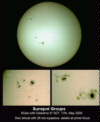
Solar Images
There are many Hydrogen-alpha images on ths page showing surface detail and prominences. But for a very quick visit here are a couple of particular interest. A Coronal Mass Ejection (CME) on 2nd March 2015, and a very large prominence on 23rd April 2015. I had a bit of fun with that one!
Astronomy doesn't only have to take place at night! After all, the nearest star to us is our own Sun. But a safe Solar Filter is an absolute must. See the description of the Baader Solar Film filter. 2000 is a good year for Sunspots! The faint circles on the sunspot closeups in the right hand group are simply shadows of dust particles, probably on the CCD chip.
 -
- -
-
On 26th. June a quick look with the 80WA showed numerous sunspots, including an attractive triangle of large spots, so out with the C8. Unfortunately it clouded over before I got the final group, but I imaged it the following morning (further onto the disc). Incidentally, any of the three large spots would swallow the Earth with plenty of room to spare!

After an interminable period of cloud and rain, the weather relented on 16th. July, and I obtained these images. A very messy Sun!

The third and fourth weeks of September 2000 saw the largest Sun Spot group for many years (Active Region 9169). The weather was variable, with some cloudy days, but I was able to image it on three seperate occasions. The first on September 21st. 2000 and last on the 27th. were taken hurriedly in the morning, and the telescope was not fully temperature stabilised on both occasions. But the middle set was taken at the Loughton Astronomical Society Star Party at Thetford, Norfolk, on September 23rd. and the 'scope was nicely settled down. Although there was a breeze, the atmosphere was quite stable, and crisp images were possible. The group was at its best then, and was breaking up by the 27th.
|
September 21st., Boldon, Tyne & Wear, 1030 UST |
|
|
September 23rd., Thetford, Norfolk, 1245 UST
|
|
|
September 27th., Boldon, Tyne & Wear, 0845 UST |
|
Here is an impressive group captured on 30th. March 2001, using my Olympus 2100UZ Digital Camera afocal with 40 mm eyepiece on my Meade LX90. Spots at maximum optical zoom (x10). Thin cloud arrived while I was photographing the full disc. |
|
June 2001 saw my trip to Zambia for the Total Eclipse on 21st. Full details and travelogue on my Solar Eclipse page. But here are a couple of tasters. This is the view at totality.
During my trip a fellow camper (not of our party) allowed me to use his Coronado Solarscope, and I was able to take a photograph through it, showing prominences and surface markings. |

|
|
During mid August 2002 although solar maximum was supposedly past, a huge spot, the largest on record for many years, traversed the Sun. 3 days in the life, and the immensity of the spot can be gauged from the scale overlay of Jupiter in the middle image. Unfortunately seeing conditions were poor on all three days with a mixture of broken thin cloud and upper atmosphere turbulence. Solar discs with the Olympus 2100 afocal with 40 mm eyepiece, close ups Vesta Pro at prime focus of LX90 |
|
On the 11th. September 2002 - the anniversary of the tragic events in New York - a large group again rotated into view. Almost certainly a development of the above. With my newly acquired Infrared blocking filter, I consider the detail to be much improved. Or it might just have been better seeing! This activity may also have triggered the Aurora of 7th.September - here on the Olympus page. Disc with Olympus 2100 afocal with 40 mm eyepiece, close up mosaic of two frames with Vesta Pro at prime focus of LX90 |
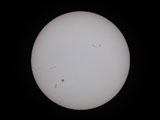 |
|
Dawn on 31st. May featured an Annular Eclipse of the Sun, partial throughout most of the British Isles, but with a full annulus visible from sites in the North of Scotland. British weather being what it is, I decided not to travel North, but simply take the 5 mile trip to the North Sea coast and watch it from a local headland (Souter Point Lighthouse, South Shields), along with three other members of the South Shields Astronomical Society. Although haze on the horizon unfortunately masked the maximum obstruction which would have shown a pair of 'horns' rising from the sea, ten minutes after maximum the sun became visible through the haze, and we were rewarded with a view of the entire remainder of the eclipse. |
  |
|
The haze cut down the sun's light to a level which was safe to observe without filters for most of the eclipse, even through the LX90, and superb views of the deep red eclipsed sun were seen. I took several photographs, the best shown here. The closeups were afocal through the telescope with a 40 mm eyepiece, the long shot direct, zoomed to 100 mm. |
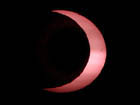 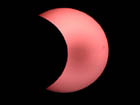 |
|
The uncoloured image is a single frame from an AVI (DivX codec) showing the final phase of the eclipse, filtered with Baader Solar film. This was taken using the Vesta Pro Webcam with a 135 mm lens. Click on the image to view the (32 KB) AVI. Depending on the configuration of your browser you may need to download the AVI first. |
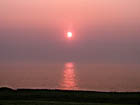 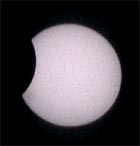 |
|
Digital Magic! When I was in Africa in 2001 for the Solar Eclipse, I was able to take a Hydrogen Alpha image of the Sun through a Coronado telescope belonging to a fellow camper. See Eureka Page. It showed prominences, although I was rather disappointed by the lack of surface detail. But now, on applying the techniques suggested by James Weightman in the July 2004 Sky and Telescope magazine, all is revealed! There is some vignetting from the lens system, barely noticeable in the original brighter image, but the majority of the frame is acceptable, and shows much more of the surface structure than was at first apparent. For anyone who has read the article, the Green channel was the one to use in this case.
|
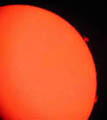
|
|
In June 2005 I bought new a Solarview50 Hydrogen Alpha telescope to replace my (secondhand) Helios 1. I've been rather remiss in posting images, but here is a selection from late 2005. Firstly a montage from 13th. August 2005. |
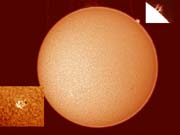 |
|
Here is a superb prominence from 25th. September 2005. I just happened to take a look in the late afternoon, and was extremely lucky to capture this. This and all following images were taken using my Artemis285 CCD camera, some of the prominence and spot details with a 2x Barlow as well. |
 |
|
Although the Sun at this time is in a period of minimum activity, nevertheless on 12th. November 2005 there were some nice prominences visible, and the one to the lower left of this image was associated with an active Sunspot area which appeared over the next few days. For once I was favoured with a run of fine days, and was able to capture a succession of images showing the progress of the spot across the Sun's disc. |
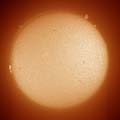 |
|
Here are the Disc and Spot on 15th. November 2005 |
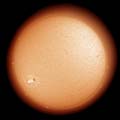  |
|
The Spot on 16th. November - I didn't have time to get the Disc. |
 |
|
17th. November |
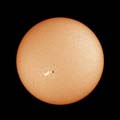  |
|
18th. November It gives one pause for thought when realising that the major spot would easily swallow the Earth, and the distance between the major and minor spot is 2/3 the distance between the Earth and the Moon.
|
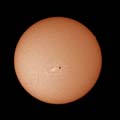  |
|
19th. November
|
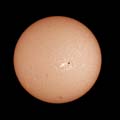  |
|
The clouds returned, so no more of that sequence. But here is an interesting prominence from 12th. December 2005.
|
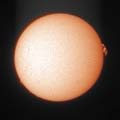 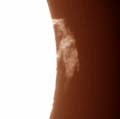 |
|
Here's an interesting prominence from 23rd. April 2006. Artemis camera and Solarview 50. Disc at prime focus, prominence detail with 2x Barlow. |
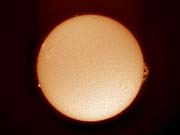
|
|
An interesting Sunspot crossed in early February 2007, and I was able to capture it on 2nd. Artemis 285 and Solarscope 50. |
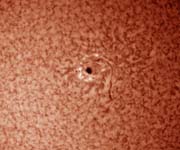 |
|
With the Solar minimum dragging on, no worthwhile H-alpha images have been obtained for some time. But during a few days' stay at Kielder in April 2008, although the latter part of the stay was predominantly cloudy, Wednesday (9th) was a reasonably sunny day with many breaks in the clouds. And the upper atmosphere was cold enough to produce ice crystals in the upper atmosphere and grant us a Solar Halo. When a cloud covered the Sun, there was enough contrast to photograph the phenomenon directly. As for the Lunar Halo photographed a few weeks earlier, the circle is always 44 degrees in diameter. Larger image |
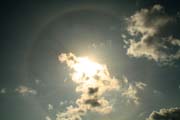 |
|
During a trip to Les Granges in 2009 I took my Solarview 50 and QHY5 guide camera - it has a good size chip for use with that telescope. Although only 8-bit, I was able to capture this image on 23rd September. |
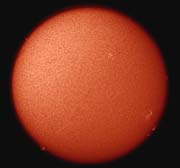 |
|
At the end of June 2010, finally our long awaited extended holiday began, and after some interesting stops in America we arrived in French Polynesia for the July 11th Total Solar Eclipse. Although staying on Tahiti and the adjoining Moorea, to view the eclipse we flew to Tatakoto Atoll which was situated very close to the centre line. This was the diamond ring at second contact, with some Baily's beads evident along with prominences. All these Solar images were taken using my Canon 350D camera and Canon 400 mm f5.6 L lens, and ISO 100. This single frame 1/1000 second. Full size. |
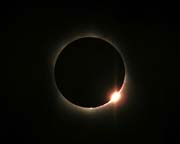 |
|
We witnessed 4 1/2 minutes of totality, but as always the time flew past. Nevertheless I was able to view the event while taking a range of photos. This is a composite of several frames between 1/1000 and 1 second. Despite the thin haze, I also succeeded in capturing Earthshine, and several stars, the brightest being magnitude 3.5 Delta Geminorum (above the disc). This image appeared in the December 2010 issue of Sky at Night magazine |
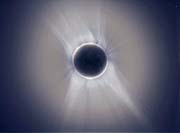 |
|
All too soon came third contact with again a nice diamond ring and prominences. We were very fortunate with the weather - clouds before and after, indeed totally obscured 10 minutes later. Phew! |
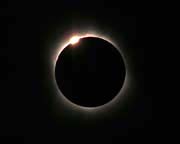 |
|
As well as taking close ups I managed a wide angle shot with my Panasonic TZ5 on a lightweight tripod. The Sun was washed out, but my wife fortunately took a photo with her Canon Ixus 40 at a shorter exposure nicely showing the 'black dot', so this is again a composite. Note Mercury lower right of the Sun. This and the above two pictures featured in the August BBC 'Sky at Night' programme with Sir Patrick Moore, and this photo appeared in the September 2010 issue of Astronomy Now. |
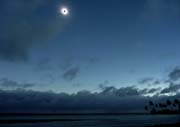 |
|
Several attractive prominences and some active areas with small spots on 2nd September 2012. Artemis 285 with Solarscope 50 |
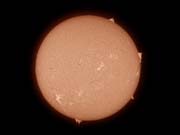 |
|
On 2nd March 2015 I was doing some tests with the forthcoming partial eclipse in mind, and spotted this substantial detached prominence. Rather faint, hence the stretched background. But interesting! It would seem that I caught the start of a major Coronal Mass Ejection. I took my image around 1430 UT, the 'official' image was an hour later. The link referred to in that image is not active on my site, but this YouTube offering shows the progress of the CME very well, although I do not know how long it will be available. It opens in a new window - YouTube does not like frames! Artemis 285 on Solarview50. Combination of 20 x 0.01 second exposures, processed in K3CCDTools and Photoshop. |
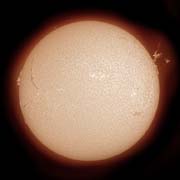
|
|
On 20th March 2015 there was a Total Solar eclipse in the North Atlantic. Unfortunately the line of totality did not pass over the UK, but from my Northumberland location the Sun was 92% eclipsed - a substantial partial eclipse. But as usual the fickle UK weather did not play fair! Maximum eclipse occurred shortly after 10.30 am. The previous day had been beautifully clear all morning, alas this was not the case on eclipse day with substantial cloud cover. Nevertheless I was all set with both white light and Hydrogen-alpha filters set up in my Observatory. First contact was completely obscured, but eventually the clouds started to thin and not only was it safe to view direct, I was able to take unfiltered photographs with my Panasonic TZ5 compact camera at full zoom, this was one of the better ones. |
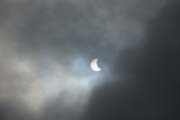 |
|
As time passed, the clouds thinned further and eventually I was able to start taking images with the filtered cameras. These 'white light' images were taken using Baader Solar film and my Canon 700D on my Meade 127 refractor (950 mm focal length). Maximum eclipse and nearing the end of the eclipse. There is an MP4 video here showing the sequence of all the useable frames. |
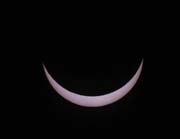 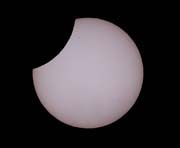 |
|
I also had my Artemis 285 camera fitted to my Solarview50 Hydrogen-alpha telescope, again these are maximum and near the end. There were some interesting prominences and filaments. Also an MP4 video here. |
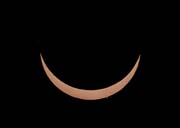 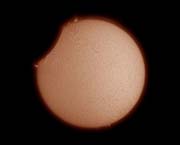 |
|
The Sun has had a relatively quiet cycle this time round, but on 23rd. April 2015 it sported a huge prominence which I was able to capture. Artemis 285 on Solarview50 Hydrogen-alpha telescope. Interestingly when I came to process the images I noticed I had another folder labelled April 23rd. BUT it was from 2006, when again there was an enormous prominence!! Quite a coincidence!! It can be found here. |
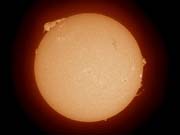
|
|
A flight of fancy! I see a strange caterpillar like creature crawling around the rim of the Sun to reach its offspring which is looking eagerly towards its parent ;-) |
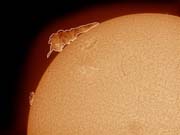 |
|
A few days later (27th April) the prominence had rotated onto the face of the Sun, with only a faint tail of the filament showing as a prominence - only just visible in this image, I was fighting clouds! |
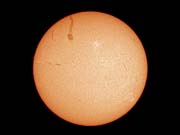 |
|
In early March 2016 we went on a trip to Indonesia - an organised tour which visited several places of interest including a *very* hot climb part way up Anak Krakatau! Hopefully I will get round to doing a travelogue. But the primary purpose of the holiday was to view the Solar Eclipse on 9th March. We were located in the courtyard of the Sultan's Palace, Ternate, a good open location with plenty of atmosphere - locals etc. At first contact the sky was beautifully clear, but there was a worrying patch of high cloud to the East. Unfortunately it moved across the Sun after about 30 minutes, and remained until 10 minutes after totality. It wasn't so thick as to block the Sun out altogether, but the outer corona was completely obscured. So my planned exposure sequence was out the window, and I just had to play seat of the pants as the cloud thickness varied, using live view on my Canon 700D. Despite taking some longer exposures (around 1.5 seconds), the cloud ruined them, and my best effort was this one. 0.3 seconds, 400L Canon lens externally stopped to f7, ISO 100. Just before third contact, a nice view of the large prominence and the start of Baily's beads at the top of the image. Cropped from the full frame. Full Size. This image appeared in the Eclipse feature in May 2016 Astronomy Now magazine |
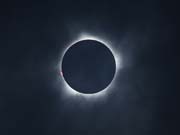 |
|
One of the group (the leader, Prof. Patricia Reiff) had a fish eye lens on a camera and took this image during totality. Venus is clearly visible, but it is also apparent just how much cloud was obscuring the corona. |
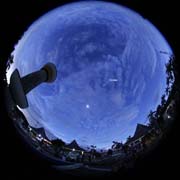 |
|
As I mention above, we climbed part of the way up Anak Krakatau - 'The Child of Krakatoa' which lies in the Sunda Strait midway between Java and Sumatra. You can see the path in this photo, it took us up around 400 feet of the 1000 foot volcano. Larger image |
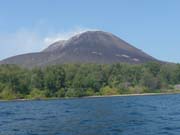 |
|
It was extremely hot, not just from the sun but from the volcanic heat underfoot. I just made it - I was suffering from a tummy bug and became quickly dehydrated despite carrying water with me. Larger image |
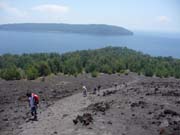 |
|
Because of my physical state I went down before the rest of the party, but after drinking more water and resting for a while was rewarded by the visit of a large (around 6 feet long) monitor lizard. Larger image |
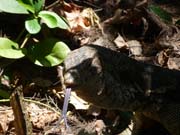 |
|
I've put this Krakatau section here for now because on 22nd December 2018 a large portion of the volcano slid into the sea, causing a tsunami which hit the coasts of Java and Sumatra without warning, causing the deaths of over 400 people with a further 40,000 displaced. This radar picture shows the huge amount lost - around 2/3rds of the mass and the height reduced from 340 metres to 110 metres. The remaining area includes the path we climbed and the forest below, all of which were inundated by the tsunami. So the monitor will have perished, and probably any other life on the rest of the Island which is still erupting ferociously as I write this (29th December). |
 |
|
These satellite photographs show the devastating change to the island. The main cone completely collapsed into the sea, and the rest of the island became a desert of mud and rock. |
 |
|
Transit of Mercury On 9th May 2016 there was a (relatively) rare transit of Mercury across the face of the Sun. Visible in its entirety from the UK. I set up two imaging systems on my Observatory mount, for white light my Canon 700D on Meade 127 refractor with Baader Solar film, for Hydrogen-alpha light my Artemis 285 on Solarscope50. Both set up with computer control to take an image every 5 minutes for the whole transit which lasted for just over 7 1/2 hours . Some problems unfortunately - exposure times for the Canon which were set too long at first - some unnoticed hazy cloud cleared after the initial set up, so early frames were over exposed. Then towards the end as the Sun lowered into horizon haze, the exposure times had to be increased again. More fortunate with the H-a, although the camera slipped at one point, rotating through 90 degrees, unnoticed for a while. Also unnoticed was a failure of the power supply to the Canon so 40 minutes were lost! Seeing was poor, so many frames were a bit fuzzy. But here is first contact with both cameras. Full size white light here. |
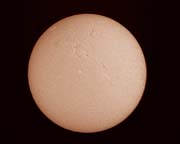
|
|
As Mercury progressed, seeing continued to vary, but I have selected frames which are as good as they get. Full size white light here. |
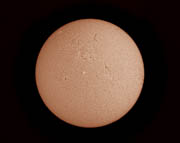
|
|
Unfortunately at the time of last contact, tree leaves and branches got in the way, and of course the low altitude did not help the seeing. But here is the result anyway! A couple of H-a images - the narrow wave band at the red end of the spectrum survives the thick atmosphere better. No full size for the white light, reddened and blurred by the low altitude (9.5 degrees).
I hope to produce a video of the full passage. probably in H-alpha, more interesting with the surface features. But correcting the rotation when the camera slipped will take a bit of doing, never mind processing and aligning each image. Watch this space! |
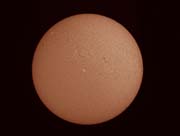
|
|
I posted the above GPCAM2 Solar images on the UKAI group Solar section, and came across highly detailed images obtained using a Daystar Quark 'eyepiece' Hydrogen-alpha filter. This filter fits on a telescope like a standard eyepiece, so can benefit by the resolution of a refractor larger than most small Ha dedicated telescopes like my Solarview50 without breaking the Bank! The built in Barlow lens substantially increase the focal length of the system, so with the small chip of the GPCAM2 only small areas of the Sun can be captured at any one time, but the potential for fine detail is there given good seeing conditions. So I bought one from Altair Astro complete with 2" energy rejection filter and interference eliminator to remove 'Newton's Rings'. And fitted to my TMB105 refractor it works very well. Still learning and finding the correct settings, but here are a couple of images from 8th June 2016 when the Sun decided to show itself briefly after days of cloud. Early evening so a bit low in the sky and only moderate seeing, but shows what the system is capable of. Need a good active sunspot to really show it off! Both images are of course stacks of 100 or more monochrome sub frames selected from several hundred using Registax6. Further processed and coloured in Photoshop. |
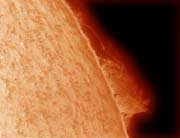
|
|
Spot 12579 followed the earlier groups and seemed to be developing, but as can be seen from these images taken on 23rd and 24th August 2016 it started to decay quite quickly. Unfortunately poor weather/lack of opportunity prevented further images and checking on the Kanzelhöhe Observatory web site a few days later showed the spots had disappeared altogether leaving only a slightly disturbed area.. Altair GPCAM2 mono on Quark and TMB 105 refractor. |
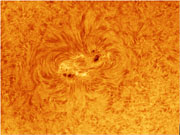
|
|
21st August 2017 saw a Solar Eclipse pass across central USA. Although totality was relatively short, around 2 min 45 secs maximum duration near the town of Carbondale Illinois, it was dubbed 'The Great American Eclipse' and was probably seen by more people than ever before. I was fortunate in joining a group organised by Omega Holidays which decided to watch from a site 'Menan Buttes' near Idaho Falls. 2 mins 18 secs, but chosen for its good weather prospects. And did not disappoint! Wall to wall cloudless sky and at the altitude of around 5000 ft. above sea level a crisp clear view. Second contact produced a beautiful diamond ring with Baily's Beads and prominences nicely visible. Canon 700D with 400 mm Canon L lens externally stopped to f 7.1 (see this description) unfiltered at 1/2000 second. Full size. We were accompanied by Pete Lawrence, Dr. Paul Abel, and the impressionist Jon Culshaw who introduced excellent presentations by the other two and was extremely entertaining! |
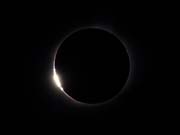 |
|
For totality I used a range of exposures from 1/400 to 2 seconds, and combined them in Photoshop to produce this image - a pretty close representation of what was visible through small binoculars. WARNING - it is safe to use unfiltered binoculars, but only during full totality. Even the diamond ring can cause serious eye damage when viewed through optical aids such as binoculars or a telescope. Larger image - approximately half size. There are several stars visible - star identification in this larger image. This image was Picture of the Month in the October 2017 issue and also appeared in the January 2024 issue of Astronomy Now |
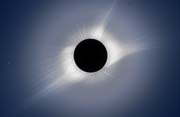 |
|
Here is fourth contact diamond ring, again clearly showing Baily's Beads and prominences. Full size. |
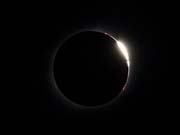 |
|
There were several small sunspots visible. Taken with a Solar filter of course (Baader film). Larger image |
 |
|
The sky was beautifully clear for the whole eclipse, so here is an animated GIF of the entire sequence. Click on the thumbnail for a medium size GIF (755KB) or here for a larger one (4.48MB) |
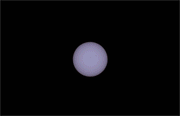 |
|
Earthshine, often seen when the Moon is recently new, is caused by light from an illuminated Earth lighting the dark part of the Moon as viewed from Earth - the equivalent of Moonlight. It was just visible in my 2 second exposure, so I have patched it into the composite here. Larger size. It is very unusual for a particular location to benefit from totality within a few years. But in April 2024 Carbondale Illinois is even closer to the centreline than on this occasion, and will experience over 4 minutes of totality - lucky them! I may go to that one, but will be approaching 81 years of age - maybe too decrepit or even gone by then! Time will tell.... |
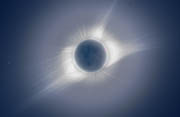 |
Now August 2019 and no Solar images for two years. Why?? Well, the Sun has been unusually quiet for the last two years, with only an occasional very small sunspot. It is experiencing a deep Solar minimum. But hopefully will spring back to life soon. Watch this space!
|
On 11th November 2019 there was a transit of Mercury across the face of the Sun. due to start at 1235, but the Sun would set well before the end of the transit. Nevertheless I hoped to catch as much as possible. Unfortunately the weather was not kind here in Northumberland, particularly at the start of this unusual event, but I managed to capture it just after the start. Mercury is the tiny black dot at around 8.30-o-clock right at the edge of the Sun's disc. An hour or so later the skies cleared nicely for a short while and I was able to get a better full disc image with Mercury about a 1/4 of the way across, just below the centreline. Then the rain arrived, and I never got another clear image. But better than nothing, since there isn't another transit until November 2032, and that will have already started before Sunrise. Full size start here, later here. Taken using an Altair GPCAM3 178M on Solarview50 H-alpha telescope. I bought this camera to replace the GPCAM2 which didn't quite cover the disc of the Sun, also the new camera has smaller pixels, so hopefully better definition - no Barlow needed for prominences and sunspots. I'd hope to get a whole sequence until the Sun was almost set, but not to be. A tiny hint of a prominence at 9-0-clock on the later image, but that's all - the Sun is in a very quiet mood at the moment! |
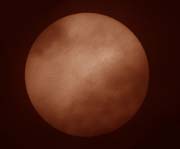
|
|
Towards the end of January 2021 I had an accident with my Solarview50 Ha telescope which detached the etalon thereby needing repair in the Isle of Man. They had an awful time fixing it - the etalon plates just would not go back together. Until they tried replacement spacers - most unusual for them to be damaged, and then the magic happened. I got the 'scope back on 8th June, just in time for the partial eclipse on 10th, (guaranteeing full cloud cover!), but no decent clear spells. 9th June a bit better, and some definite action so I decided to go for an image with my GPCAM3. And when I stretched things, I found what might be a coronal mass ejection, certainly clouds of gas thrown a huge distance from Sunspot AR2831 - the furthest section is probably at least 200,000 miles out. Lucky strike! NASA Solar Observatory image here. As you can see that was captured at 12.08 UT, my image was at 12.16 UT. Slight haze so only the brightest parts captured. Full size |
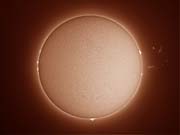 |
|
On 10th June 2021 there was a partial Solar Eclipse in the UK (part of an Annular Eclipse over the Arctic). Like many others in the UK I was clouded out for much of the time. But managed a bit of Hydrogen-Alpha as well as white light. so here are a couple of the former, one combined with a longer exposure to capture prominences. Solarview 50 with GPCAM3 178M. The upper image, shortly after first contact, was timed at 0910 UT, larger image here.
The lower at 1117 UT, larger image here. Nothing particular in the few white light images, so not presented.
It was cloudy for the maximum eclipse, but also like others I was able to use a consumer camera - TZ70 on full 30x optical zoom to get a shot or two through the clouds. Cropped from the original. |
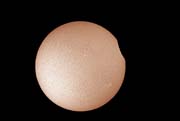
|
|
Alas my beloved Solarview 50 is back in the Isle of Man while Helmut wrestles with getting it set up at its best after it was damaged several months ago. But now that the Sun has started to wake up after the long minimum this show on 17th December 2021 was too good to miss. So on with a white light filter on my TS65 Quad and an avi (used 30 frames of 74) with my GPCAM3 mono. It was just after noon, so the Sun was almost at its highest, but still very low at less than 12 degrees altitude. And in thin haze. But worth a go and a bit of tweaking in software got this result. Full Size. |
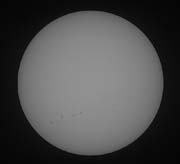 |
|
Well, how lucky can you get! Only 3 days after the previous Aurora there was another strong outburst. This time, there was only a diffuse show in the North. Larger image. |
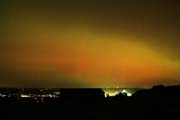 |
|
But when I returned from the North facing road view and went into my back South facing garden it was all happening! This view to the East. Larger image.
This to the West. Larger image.
This to the South. Larger image.
This also to the South but more overhead - the Summer triangle immersed in the aurora. 'Mouseover' the medium size for some identification. Larger image. |
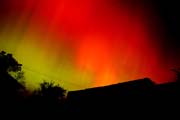
|
|
These photos, the best of the many I took, and of course which have been processed in Photoshop to make the colours really shine, were all taken around 10 pm. But as can be seen from this chart, the aurora became even stronger later. I did have another look before going to bed around midnight, and the intensity had reduced, but I missed the later peak. Nevertheless I was very happy with what I did see - the red colour, particularly in the East facing image was clearly visible to the naked eye. |
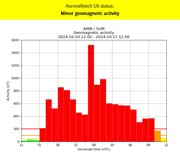 |
|
As you can see above, when I compared the latest 60mm Ha image against one from the 'Gong' Learmonth site, I realised that a lot of surface detail, particularly plages, was missing. Helmut (Solarscope) wondered if the blocking filter needed adjusting. But I'd had enough - more trial and error with no guarantee of success, and time marches on. He took everything back with no further charges, and after only a small amount of soul searching I ordered an Acuter 40. It arrived on the next day (9th January) from FLO, but too late to do anything but a quick look - the Sun was well down. Looking promising, and the following day cleared nicely after earlier clouds. So I did some visual - very nice, then took some images with my Altair GPCAM3 178M camera. But it seemed that as for Mario Stroblmayr, in his review there was some leakage. The images would not come into really crisp focus. So anyway I ordered a UV/IR filter to try. That image was taken with the Sun near its maximum altitude at 13 degrees. But although time was getting on with the Sun lowering, I had time to fit the etalon to the front of my TSQuad (65mm, 420 mm fl), dew shield removed. It fitted nice and square without the large screw adapter, but when taped on of course I couldn't tune it. So set the tuning ring about half way then fitted it. And took an image when the Sun was at an altitude of around 10 degrees. I wasn't really expecting much, but certainly the image looked crisper on the computer screen. So I'm showing four images. The first is the Australia Learmonth Observatory image for comparison. Then mine from the Acuter telescope, third one mine using the TSQuad. The Quad image needed longer exposures in the avi - possibly because lower in the sky. But seemed to focus better with more contrast, maybe generally less leakage passed through due to the accurate triplet lens (and the built in flattener). Both those images are stacks of 33 frames in Registax and waveletted identically. No further processing, which done in Photoshop improves them further, but for accurate comparison..... The fourth image is the TSquad one with more processing, full size and coloured. So despite the possible need for a UV/IR filter, I'm seriously impressed with the performance of this little scope. Once I've tried the UV/IR filter on the Acuter scope, depending on the result I might make an adapter to use the etalon etc. on my TSQuad. A couple of days later. The UV/IR filter arrived but not tested yet. In the meantime I found that the blocking diagonal already has an IR flter installed. So there may be no improvement. Watch this space! |
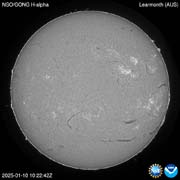
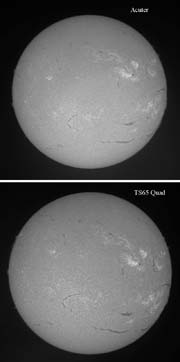
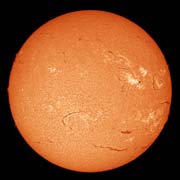 |
|
The camera I use for my Solar images is an Altair GPCAM3 178M which nicely encompasses the Sun on my Solar H-alpha telescope, formerly the Solarview50, now the Acuter Phoenix 40 which is performing superbly. But in the excellent review which helped me decide on the Acuter, Mario had a problem which was cured by the addition of a UV/IR filter. As I stated above I wasn't absolutely certain whether I needed one, but Altair provide a custom filter for my camera so I ordered one anyway. It duly arrived and clear days on 15th and 16th January 2025 gave me an opportunity to perform final tests. Because as I later discovered there was already an IR blocking filter on my telescope diagonal filter I wasn't sure if the new one would make much difference. What I did discover from the review was that Mario's instrument did not initially have an IR blocker on its diagonal, hence his problems. My camera already had a filter on the front, described as 'Removable Clear blocking filter with AR anti-reflection coatings 350-1050nm'. The above of these two images was taken on January 16th 2025 using that filter. Then I removed it and replaced it with the new filter with the result of the lower image. AR coated 380-1100nm . A definite improvement in contrast. Also the image on the monitor was much brighter - I could reduce the exposure time by almost 2/3. I can only assume that the new filter is better suited to the Hydrogen-alpha wavelength, or it may be that the shorter exposure times have contributed to the better quality image by better 'freezing' of the seeing. But whatever the reason, I will always use it for this purpose. These images were the result of align and stack 33 of 107 frames in Registax 6, identical processing, but no post processing, so a fair comparison. |
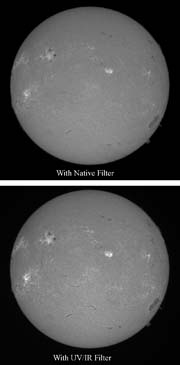 |
|
So here is the final fully processed result. I show both monochrome and coloured images - many people prefer the monochrome which I agree tends better to show the contrast between surface features. Although using the Acuter filters on my TSQuad telescope initially appeared superior, when the new filter was fitted to my camera there was no discernible improvement, so I will happily stick with the Acuter telescope.
|
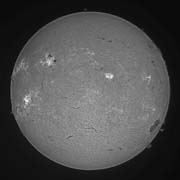
|
|
Sun Westering when the clouds cleared, so altitude only 15 degrees. But I knew there was a good prominence, so worth a go. Acuter 40, 33 subs from 107, processed in Registax and Photoshop. |
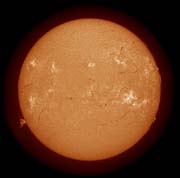 |
|
When I first bought my Acuter Elite Phoenix 40 I tried mounting the etalon on my TS65 Quad - it fitted snugly with the dew shield removed and was safely taped on with duct tape. It seemed at that time to give a slightly more contrasty image than the Acuter telescope, but after changing the camera front window there seemed little to choose between them. Anyway I had another play on 27th February 2025 when I found I could adjust the tuning - with the main body of the etalon taped to the quad it was still possible to alter the tuning with the thin rim. But again there was very little difference apart from a slightly bigger image due to the longer (420 mm vs 400 mm) focal length, so I won't be going to the trouble of making a proper adapter. Anyway, I can't use my Herschel wedge with the Quad because of the location of the flattener lens. I had bought a 1.25 inch wedge from Altair Astro, and it fits nicely in the Acuter case. So all I need in one place (apart from a mount of course!) Here is the image. Not much in the way of prominences, but a fine scattering of filaments and active areas. 34 subs out of 120, stacked in Registax, finished in Photoshop. Full size |
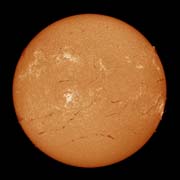 |
|
After many years of using Baader Solar Film for white light images, with the Acuter being an 'all in one' telescope, I finally invested in a 1 1/4 inch Herschel wedge which nicely fits in the carry case. Safer and more convenient than film. And this is an image taken with that system on 6th March 2025 . The wedge will just safely go on my TMB 105 which will give a crisper image and of course is a colour corrected triplet. Unfortunately because my nice TS65 Quad is of Petzval construction, direct sunlight could damage the built in flattener lens, so no wedge use there. As the Acuter is an achromat, I intend to use a colour, perhaps narrowband filter in future to improve definition. But this will do for a start. Full size |
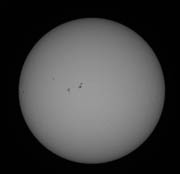 |
|
At the beginning of March 2025 I started having some problems with uneven tuning of my Acuter Solar scope. A couple of fine days gave me the opportunity to do some testing with limited success, but it appeared that the best area was right to one side of the imaging sensor. Then some tests with a laser showed that the focuser was angled by a small amount. I didn't know quite where the problem lay, but I tried a standard 2" to 1 1/4" adapter in place of the rotatable unit supplied with the scope, and then it all looked much better. That was on 8th March. There was an interesting prominence showing, but on the 9th it had developed considerably so here is the result. As you can see the disc is now tuned evenly (and was in the centre of the imaging sensor). Hopefully problem permanently solved! 30 from 114 frames (1 minute avi using the ObservatoryWindows XP computer for convenience - I had been doing a lot of testing!) Stacked in Registax, final processing in Photoshop. Full size |
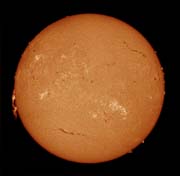 |
|
Viewing theSun in Hydrogen-alpha light requires the use of expensive precision filters. But of course ordinary white light is also of interest and easy to view safely using either specialised Solar film or a Herschel Wedge to dramatically reduce the brightness. I now have an Altair Astro Herschel Wedge - less prone to damage than Solar film and straightforward to use. And this is the result of using it on my Acuter 40 telescope with the H-a filter sets removed. I found that rather than completely removing the front adapter to reveal a full 80 mm aperture, the image was slightly crisper with it still in place giving a 50mm aperture. Probably due to the effective f8 ratio instead of the native f5. 30 frames from 191 with GPCAM3 178M stacked in Registax, final processing in Photoshop. As you can see there are numerous Sunspots which correspond to the active areas in the Hydrogen alpha image above. |
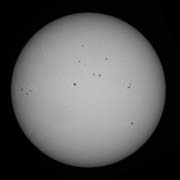 |
|
Cloudy again today, 17th March 2025, so a bit of fun with figures. These are the dimensions I used: Moon average distance 384,800 km And using part of my recent (March15th) Solar image here is the result, all to scale with the Moon at its average distance from us. You can just see it to the right of the Earth. Reminds me of Carl Sagan's Reflections on a 'Pale blue dot'. |
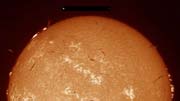 |
|
If the above makes you feel small, consider this. NML Cygni is possibly the largest known star. A red supergiant, about 5300 light years away in Cygnus. If in place of our Sun, its surface could extend past Jupiter! |
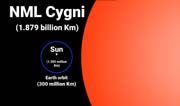 |
|
Another fine day and interesting prominences making it worth imaging. Acuter 40, 28 frames from 183 stack and initial process in Registax, finished in Photoshop. |
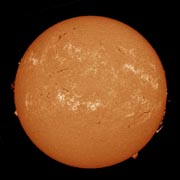 |
|
After the disappointment of the cloudy partial eclipse above, the next day (30th March 2025) dawned beautifully clear and sunny. So I was able to capture this image. Not much in the way of prominences, but plenty surface activity. The active area with the large sun spot to the left side (AR14046) had emitted a substantial coronal mass ejection two days previously. If it is still as active and flares up again when pointing towards the Earth we might expect some beautiful Aurorae. Acuter 40, 41 frames from 200, stacked and waveletted in Registax, finished in Photoshop. |
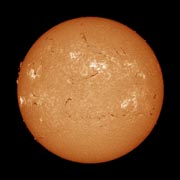 |
|
I still think my Acuter Elite Phoenix 40 is an excellent little scope, fighting well above its weight in H- alpha, and a reasonable 80mm ordinary refractor as well. And with all the bits needed for both applications , fantastic value for money. But I have had some problems with it, primarily occasional loss of tuning towards one side of the field of view, more readily obvious when imaging. Tests with a laser showed that the alignment of the focuser assembly was not fully concentric with the front of the tube. The corollary of which meant that the centre line of the objective and of course the front mounted etalon was not central to the blocking filter. I generally managed with a bit of fiddling to get things right as can be seen from my recent images. But shortly after I got the scope, out of interest I fixed the etalon to the front of my little TS65 Quad apo refractor. 65 mm aperture, 420mm focal length . A temporary albeit good fit using duct tape, but not a long term thing to envisage. It seemed to work well. So I bit the bullet! I had an aluminium disc which had
been languishing in my parts bin for several years, so time
it earned its keep. A few hours work on my ancient little
Myford lathe with the usual terrifying final turning of a
thread to screw in the etalon, and all was well. Phew! With
the dew shield removed the adapter is a snug fit on the Quad
and of course securely held in place with thumbscrews. It
was definitely worth it - the Solar image is fully tuned
everywhere on the 178 sensor, and with the only slightly
longer focal length of the quad still nicely fits in the
field of view. So here are some pics of the mod, and of
course the end result of the first imaging run on 1st April
2025. 44 frames from 220, stacked and waveletted in
Registax, finished in Photoshop. If anyone else has a TS65
Quad and wants to try this, sorry I won't be able to make
you an adapter, but will happily supply a suitable
drawing. |
|
|
On May 1st 2025 a filter which I had ordered arrived from Altair Astro. Its Solar Contrast Booster Filter, which is claimed to improve the definition of white light Solar images. As mentioned above I had recently purchased their 1.25" Herschel Wedge, and the filter seemed to be a suitable add on to further improve the images. The beautifully clear sky of the previous night continued into the afternoon, so more Solar fun, this time including the wedge and filter. There was a particularly large and active sunspot group, so worth closer attention. It had been suggested on Stargazers Lounge that the Acuter 40 could stand some magnification using a Barlow type magnifier. I already have a quite old 2x Barlow, and also by Televue a 2.5x Powermate and a 3x Barlow. Unfortunately it turned out that both the Televue items produced Newton's rings on Hydrogen-alpha images, but the older Barlow was ok. For white light all was well. So here we have a full Solar disc in both Hydrogen-alpha and white light, and sunspot closeups 2x H-a and 3x white light. All with the excellent Acuter Phoenix 40, the white light with the etalon unit removed and the blocking filter unit replaced by the Herschel Wedge and new filter on the camera, so using the full 80 mm aperture. In each case 20 to 30 frames from an avi of around 200 with the Altair 178M camera. I think there is some improvement in detail on the Hydrogen-alpha images, although given the limited 40 mm aperture this is always going to be problematical. Full size images here: White light spot (Mouseover the image for some interest) |
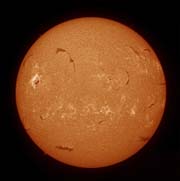
|
|
During the day on May 5th 2025 I saw this amazing prominence on the Gong site, but it was cloudy all day, although frustratingly clear further North! I really didn't want to miss it, but fortunately there were some clear patches around 6 pm which gave me the opportunity. Typically beautifully clear later of course. Anyway Altair 178M on Acuter 40. 30 frames from 179. Autostakkert, Registax and Photoshop. |
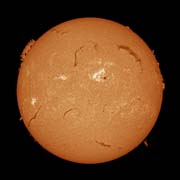 |
|
Another beautifully clear day on May 16th 2025, and spot 14087 is progressing nicely. Maybe we'll see an aurora this week, although with twilight for me, not so easy. 21 frames from 199, Altair GPCAM3 178M on Acuter 40. Autostakkert, Registax and Photoshop.
Sure enough that night there were strong alerts posted on the Aurorawatch site. But it was cloudy and I slept through (needed a good nights sleep for a chorus concert on 17th). |
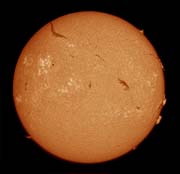
|
|
Cloud prevailed, but a brief clear patch on 6th June gave me an opportunity to image both the entire Sun and also have a go at white light granulation. Sun Acuter 40, Altair 178M camera, 20 from 200 frames, Autostakkert, Registax and Photoshop. |
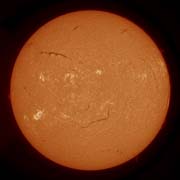 |
|
Then it clouded over, but cleared later, and I set up my Sharpstar 140 refractor with a full aperture Baader film filter. The usual 1 minute avi using my USB2 XP Observatory computer, and Altair Solar contrast booster filter on my Altair 178M camera. A Region of Interest including the main Sunspot area meant that the avi was of 460 frames, and I stacked 35 of them. This image is a crop from that image, twice full size, and I believe clearly shows granulation. I have since found that I can safely use my 1 1/4" Altair Herschel wedge with this telescope, so intend to try again, also with my 2.5x Televue . But then I will capture using my USB3 W7 laptop, and take a number of short Region of Interest avis, probably less than 10 seconds to freeze surface changes, and hope to see them when comparing final images. Watch this space! Full size |
 |
|
Although the filament mentioned in the August 3rd image above did create a decent prominence, I only saw it on the Gong system - cloudy at home. But 7th August was also interesting, so here is the result. Acuter40, Altair 178M camera, 31 frames from 297. Full size.
The seeing did not justify a close up, but the spots were worth a look. Acuter 40 hydrogen-alpha filters removed, so 80 mm objective, Altair 1.25" Herschel wedge, camera Altair 178M with Altair Solar contrast booster filter. 21 frames from 207. Full size. |
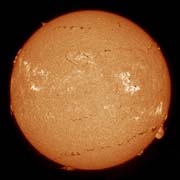
|
|
During my annual visit to the Equinox Star Party at Kelling Heath, Norfolk, there was a particularly nice sunny day on Friday 19th September. And I couldn't resist diving under a towel over my laptop to image the Sun with my Acuter Elite Phoenix 40 Solar Telescope. Numerous prominences and plenty of surface activity. A 1 minute avi with my Altair GPCAM3 178M camera on my USB3 laptop yielded 1513 frames from which I stacked the best 50 as chosen by Autostakkert. Further processing in Registax and Photoshop gave this result. While I was tidying up the image the proposed Moon Shot early next year was announced by NASA. So just to put things in perspective I couldn't resist adding the Earth and Moon to scale at scale orbital separation. The Sun might be a pretty average star, but it puts us in our place and this comparison (as I mentioned before) reminds me of Carl Sagan's wonderful Reflections on a 'Pale blue dot'. Full size This image appeared in the November 2025 Astronomy Now Gallery |
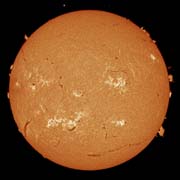 |
|
After several days of cloudy weather there was an opportunity to image the Sun on 11th October 2025. And with the large prominence it was quite a sight albeit with a small amount of haze reating a glow. Altair GPCAM3 178M as usual on the superb Acuter Elite Phoenix 40 Hydrogen Alpha Solar Scope. Full size.
The next day was clearer, and the prominence had modified. It now reminded me of the sadly missed 'Sycamore Gap' tree. Full size. |
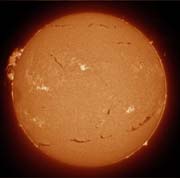
|
|
After several days (and nights!) of cloud, finally a clear morning on 7th November 2025. I had been keeping an eye on the 'Gong' site, and after a fairly quiet period noticed that a large sunspot group was rotating into view. And this is the result. A number of Aurora alerts ongoing, but so far it's been cloudy at night and anyway I was asleep! Hydrogen-alpha image using my Acuter 40 telescope, two sequences, one with longer exposures to bring up the faint prominences, then the earlier disc overlaid on that. White light with the solar filters removed from the Acuter, but this time I left the outer ring (from the etalon) in place to keep the telescope at f10, albeit with a 40mm instead of 80mm aperture. Sometimes that seems to give a slightly crisper image, maybe because the longer f-ratio has a more forgiving focal point. All using the Altair GPCAM3 128M monochrome camera. White light using an Altair 1 25" Herschel wedge and Altair G-band solar contrast filter. Processed with Autostakkert, Registax and Photoshop. |
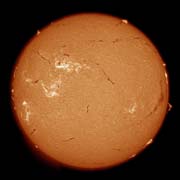
|
|
After a spell of cloudy days when anyway there was little happening on the Sun (checking on the Gong site), there were some clear spells on 25th November 2025. I had a lunch date, but just managed to squeeze these in around noon, in between passing clouds. No time for a white light close up. H-a with Acuter 40, white light Acuter with solar filter set removed, Herschel wedge without the -3.0 ND filter. Needed a Moon (-0.9 ND) filter to reduce the brightness a bit, but still ended up with 0.5 millisecond exposures! That prominence in the top left was even prettier the day before (Gong) but cloudy here. Camera Altair GPCAM3 178 M, G-band filter for white light. Processed in Autostakkert, Registax and Photoshop. |
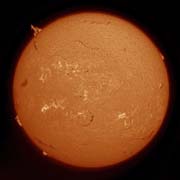
|
|
It has been interesting to follow the progress of the very large active area containing sunspots 14294, 14296 and 14298. Labelled on the medium size white light image, along with the other areas (numbers courtesy of Kanzelhöhe Observatory). So here is the result for 8th December 2025. Decently clear around noon, but still a bit hazy at the low Solar altitude (12 degrees) and too jittery for white light close up (I did try!) Nice prominences, and the huge active area is moving along 'stately as a galleon' - it will be round the corner in a few more days. Pity it wasn't more active as we might have hoped, to produce aurorae. Acuter 40 for Ha. White light with solar filters removed, Altair Herschel wedge with - 0.9 ND filter and Altair G-band filter on the camera. Camera Altair GPCAM3 178 M. Processed in Autostakkert, Registax and Photoshop. |
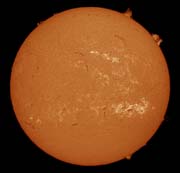
|